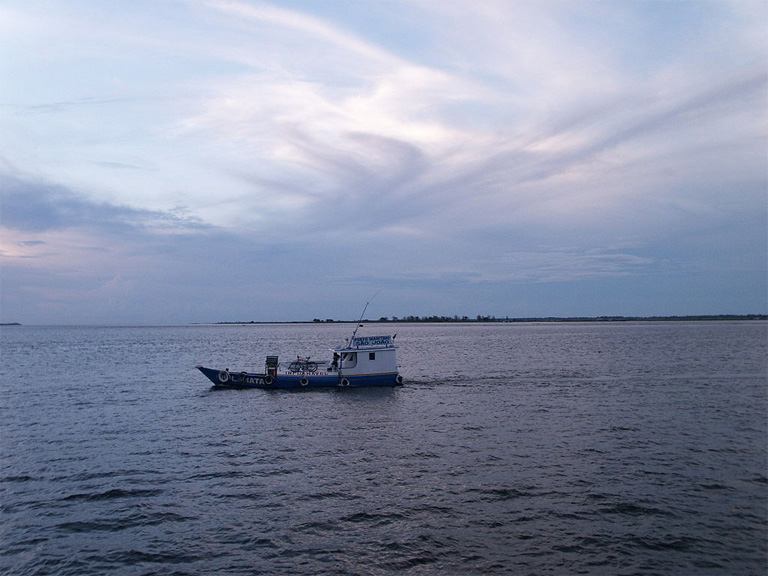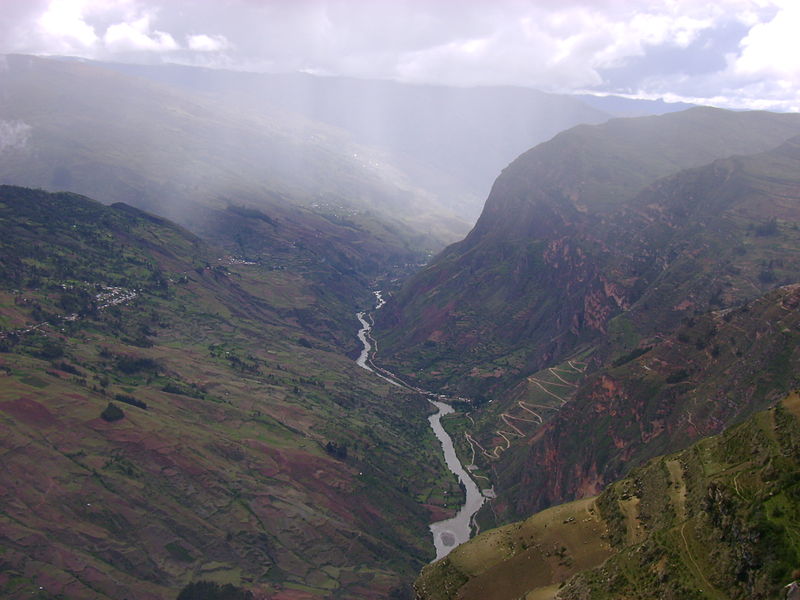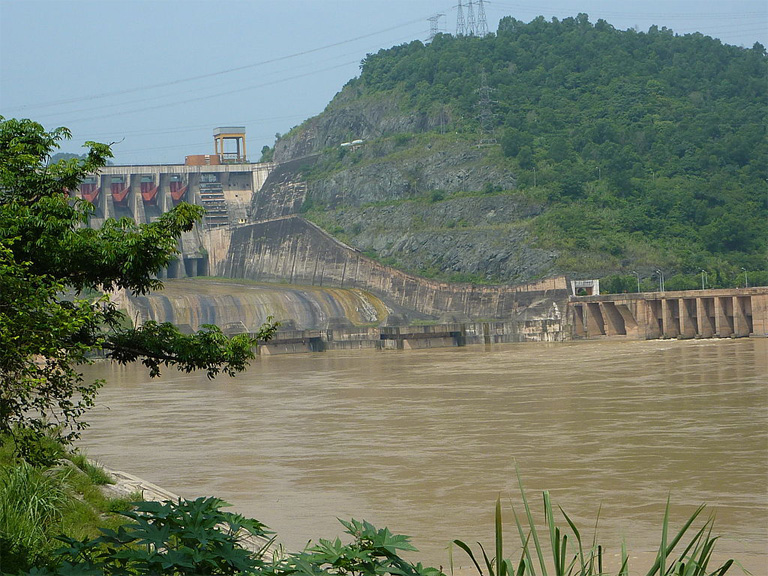- The Amazon and its tributaries currently spread vast sums of rich sediments and nutrients throughout the Amazon Basin, supporting its ecosystems and biodiversity.
- Hundreds of new dams could reduce that flow to the Amazon delta nearly to zero.
- Studies of dammed tropical rivers around the world show that dams and reservoirs can have unforeseen impacts, including a significant increase in greenhouse gas production.
A boom in dam construction is sweeping the Neotropical regions of the world. In the Amazon, the world’s largest and arguably most ecologically important river basin, hundreds of dams and reservoirs are on the drawing boards for the next few decades. Nearly every country in the region is drafting construction scenarios that in all will involve at least five of the river’s six major tributaries.
Brazil, with the largest portion of the Amazon, is leading the charge. The country has put forth plans to build at least 58 dams in the near future, including a massive and controversial project underway at Belo Monte on the Xingu River. With an installed capacity of 11,233 megawatts (MW), Belo Monte would be the world’s third-largest hydroelectric facility.
A series of dams proposed on the mainstem of the Tapajós River, considered one of the Amazon’s last truly wild tributaries, would flood nearly 200,000 hectares (766 square miles), including portions of two national parks and a national forest.

Rising energy demands, driven by an extended period of steady economic growth, are pushing governments to look closely at the Amazon’s largely untapped hydroelectric generating potential. Hydropower is the most plentiful and inexpensive source of power in the river’s remote reaches. It is being billed as reliable “clean” energy, a low-carbon alternative to fossil fuels that has the advantage of being domestically produced.
But the environmental costs of staunching the flow of so many Amazonian rivers may be high. Basin-wide hydropower development will likely have massive and irreversible environmental consequences, say scientists. In addition to their impacts on local riverside human populations, dams and the reservoirs they create, will block long-distance fish migrations and destroy critical habitat for both terrestrial and aquatic species. “All freshwater species in the Amazon basin have the potential to be affected,” says Jeff Opperman, lead freshwater scientist for The Nature Conservancy’s Great Rivers Partnership.
The problem with blocked sediments and nutrients
The complex hydrology of the Amazon and its tributaries will also be greatly affected. Dams will break the connectivity between Andean headwaters and lowland rainforests, blocking the passage of sediments and nutrients, and interrupting the seasonal floods that fertilize one of the most productive ecosystems on earth.

Studies of existing Amazon reservoirs have also revealed a disturbing fact: tropical reservoirs become choked along their rising and falling shores with massive amounts of decaying plant matter and become huge new sources of greenhouse gases. The new dams could multiply those carbon releases by vast amounts.
“This is one big ecological and social experiment on a global scale,” says Elizabeth Anderson of Florida International University.
Dams, in addition to holding back water, also trap sediment, mineral nutrients and organic material. In the Amazon, that means a lot of suspended particles: by some estimates the river delivers 1.1 billion tons of suspended sediment into the Atlantic every year, as well as 270 million tons of dissolved organic matter.

Whitewater tributaries of the Amazon get much of their café-au-lait color from particles eroded from the Andes, the source of up to 95 percent of total suspended solids in the Amazon River. (Lowland “blackwater” rivers, colored by tannins leached out of surrounding vegetation, carry less particulate matter.)
“Some of these rivers in the Amazon are practically mud for part of the year. They’re dirty rivers,” says Clinton Jenkins, an ecologist and visiting professor at Brazil’s Instituto de Pesquisas Ecológicas.
Organic materials bind to the fine silt grains, providing essential nutrients for ecosystems downstream. Nitrogen, phosphorus, carbon and other nutrients nourish flora and fauna throughout lowland forests and swamps, especially when seasonal floods cause the rivers to rise by dozens of feet, spilling over their banks and out into vast floodplains.
Examples from around the globe
The new dams will undoubtedly restrict this flow of sediments and nutrients to an astonishing degree, with significant effects that are still largely unstudied in the Amazon.
Other tropical rivers provide clues, however. A study of the Hoa Binh dam on Vietnam’s Red River — ranked ninth in the world in terms of sediment load — found that over a period of 50 years the dam had reduced the river’s yearly load of suspended sediment by an average of 61 percent, even though it only reduced water flow by 9 percent. The authors of this study also suggest that coastal erosion can intensify when river sedimentation no longer balances out with sea level rise and tectonic subsidence — something that could have big affects on Brazil’s immense Amazon river delta.

On the Mekong, as many as 133 dams are under construction or in the planning stages. According to a study by researchers at U.C. Berkeley, these dams could trap up to 96 percent of the river’s sediment supply going to its delta — that’s much more than earlier estimates of 50-75 percent. The blockage could accelerate erosion downstream and cause the sediment-starved river delta to subside.
China’s Three Gorges Project, along with other dams on the Yangtze River, have eliminated roughly 91 percent of the river’s sediment load over the past 60 years, leaving an almost clear flow below the impoundments, says a 2013 Chinese report. The river’s load of total phosphorus has been reduced by up to 77 percent a year. Since phosphorus is the limiting nutrient for bioactivity in the river, this reduction will likely have far-reaching ecological effects. It could greatly reduce the river’s primary productivity and unbalance its nutrient regime, for example, by increasing the already high ratio of nitrogen to phosphorus. Such imbalances could devastate aquatic ecosystems and species.
The dams planned for Peru’s 1,056-mile Marañón River is one concerning example in the Amazon, says Opperman. In 2011, the Peruvian government declared its intention to build 20 dams on the river’s main trunk. The largest dam, at Manseriche, could generate up to 7,550 MW and would flood over 2,000 square miles of forest. It would be a high dam with a very large reservoir located at the lowest possible point in the basin, Opperman says. “It would trap virtually all sediment and nutrients entering the reservoir, accounting for a very large portion of the sediment in the Amazon River.” The Marañón is considered the largest, and most important Amazon feeder.

The Rio Madeira, which flows through Peru, Bolivia and Brazil, provides a somewhat encouraging contrast. The Amazon’s main southern tributary is one of the muddiest rivers in the world, accounting for about half the Amazon River’s total sediment load. At the site of the 3,750-MW Jirau Dam, currently under construction in Rondônia, Brazil, the Rio Madeira carries 2.1 million tons of sediment every day.
The Jirau Dam is a run-of-the-river design, which requires little or no water storage. Run-of-the-river dams, which are subject to changing seasonal flows, are considered less ecologically damaging than dams that create large reservoirs to supply a dependable year-round supply of water. The Jirau’s renewable energy plant is the largest of its kind in the world to earn registration under the UN’s Clean Development Mechanism (CDM) program. The registration was based on an array of factors ranging from water quality and erosion to impact on indigenous peoples and biodiversity.
At the same time, researchers are worried about the accumulation of mercury in tributaries of the Madeira. Extensive gold mining in the 1980s left tons of mercury trapped in anoxic sediments, where it can be transformed into its highly toxic methylated form.
Accumulating toxins, releasing greenhouse gases
The accumulation of polluted sediments can be a serious problem in certain watersheds. One analysis of the Flix Reservoir in Spain’s Ebro River, led by researchers with the Spanish Institute of Marine Sciences and Institute of Environmental Assessment and Water Research, found that more than 360,000 tons of anthropogenic waste had accumulated in less than 40 years. Most of this was fine-grained sediment that was highly contaminated with mercury, cadmium, zinc and chromium.

An element of even greater concern to climate scientists is carbon, the byproduct of vast amounts of organic matter that ends up decomposing in reservoirs. Reservoirs worldwide are estimated to store up to 3 trillion kilograms (3.3 billion tons) of carbon. Some is transformed into carbon dioxide and some into methane, which has 28-36 times more global warming potential over a 100-year period, according to the UN Intergovernmental Panel on Climate Change. The more sediment is trapped, the more methane is produced. One study by Andreas Maeck and colleagues at the University of Koblenz-Landau in Germany, estimated that methane produced in reservoirs could increase global freshwater emissions by as much as 7 percent over current projections.
“That’s so often a selling point of dams: no carbon dioxide emissions,” Jenkins says. “But it’s a real question that needs more attention: are these dams green or not in terms of global climate change? Hydropower being sold as green can be total crap.”
There are ways to reduce the amount of sediment trapped by dams, including periodically emptying reservoirs to flush them out, and building in bypasses. But anything that brings flowing muddy water to a standstill will always leave some sediment behind. This simple fact needs to be carefully considered as plans to build hundreds of dams in Amazonia go forward.
This article is Part One of a two part series. Read Part Two here.
Citations:
- Benchimol and Peres (2015). Predicting local extinctions of Amazonian vertebrates in forest islands created by a mega dam. Biological Conservation 187: 61–72.
- Cella-Ribeiro, A. et al. (2015). Temporal and spatial distribution of young Brachyplatystoma (Siluriformes: Pimelodidae) along the rapids stretch of the Madeira River (Brazil) before the construction of two hydroelectric dams. Journal of Fish Biology 86(4): 1429-1437.
- Fearnside, P.M. (2013). Viewpoint – Decision making on Amazon dams: Politics trumps uncertainty in the Madeira River sediments controversy. Water Alternatives 6(2): 313-325
- Ferguson et al. (2011). Potential Effects of Dams on Migratory Fish in the Mekong River: Lessons from Salmon in the Fraser and Columbia Rivers. Environmental Management 47:141-159.
- Finer M and Jenkins CN (2012). Proliferation of Hydroelectric Dams in the Andean Amazon and Implications for Andes-Amazon Connectivity. PLoS ONE 7(4): e35126. doi:10.1371/journal.pone.0035126
- Guyot et al. (1996). Erosion and Sediment Yield: Global and Regional Perspectives. Proceedings of the Exeter Symposium, July. IAHS Pub no. 236.
- Kondolf G.M., Annandale G. and Rubin Z. (2015). Sediment Starvation from Dams in the Lower Mekong River Basin: Magnitude of the Effect and Potential Mitigation Opportunities. E-proceedings of the 36th IAHR World Congress, 28 June-3 July, 2015, The Hague, the Netherlands.
- Larinier M, (2001). Environmental issues, dams and fish migration. In: Mamulla G., ed. Dams, Fish and Fisheries: Opportunities, Challenges and Conflict Resolution. FAO Technical Paper No. 419. 45-89.
- Maeck, et al. (2013). Sediment Trapping by Dams Creates Methane Emission Hot Spots. Environmental Science & Technology 47, 8130−8137. doi: 10.1021/es4003907
- Pelicice F and Agostinho A. (2012). Deficient downstream passage through fish ladders: the case of Peixe Angical Dam, Tocantins River, Brazil. Neotropical Ichthyology 10(4): 705-713.
- Pelicice, F. Pompeu, P. and Agostinho, A. (2014). Large reservoirs as ecological barriers to downstream movements of Neotropical migratory fish. Fish and Fisheries. doi: 10.1111/faf.12089.
- Ruiz-Gonzalez C. et al. (2013). Effects of large river dam regulation on bacterioplankton community structure. FEMS Microbiology Ecology 84 (2013) 316–331. doi: 10.1111/1574-6941.12063
- Sá-Oliveira, J. C., Hawes, J. E., Isaac-Nahum, V. J. and Peres, C. A. (2015), Upstream and downstream responses of fish assemblages to an Eastern Amazonian hydroelectric dam. Freshwater Biology. doi: 10.1111/fwb.12628
- Vinh V.D. et al. (2014). Impact of the Hoa Binh dam (Vietnam) on water and sediment budgets in the Red River basin and delta. Hydrology and Earth Systems Sciences 18, 3987–4005. doi:10.5194/hess-18-3987-2014
- Zhou, J., M. Zhang, and P. Lu. (2013). The effect of dams on phosphorus in the middle and lower Yangtze river, Water Resources Research 49, 3659–3669, doi:10.1002/wrcr.20283.
- Kondolf G.M., Annandale G. and Rubin Z. 2015. Sediment Starvation from Dams in the Lower Mekong River Basin: Magnitude of the Effect and Potential Mitigation Opportunities. E-proceedings of the 36th IAHR World Congress, 28 June-3 July, 2015, The Hague, the Netherlands.
- Zhou, J., M. Zhang, and P. Lu. 2013. The effect of dams on phosphorus in the middle and lower Yangtze river, Water Resour. Res., 49, 3659–3669, doi:10.1002/wrcr.20283.
